Early ripe hybrid of cucumbers "Hector" for open ground
The fruits of the first generation Hector hybrid retain a spicy cucumber aroma for a long time, which makes them especially valuable. With these cucumbers, the possibilities of cooking know no limits: the hybrid is used not only in home cooking, but also in catering networks.
Read about how to grow a hybrid, what are its features and advantages, in our article.
The content of the article
Description of cucumbers Hector f1
The culture was created by Dutch breeders. Hector is one of the few hybrids known to the whole world and has won widespread respect. The hybrid was entered into the Russian State Register in 2002. Designed for outdoor cultivation.
Distinctive features
Bush culture, with a predominantly female type of flowering, there are few male flowers. Pollinated by bees. The lateral processes are poorly developed, which makes it possible to fully form and ripen the fruits.
Attention! Hybrids have numerous advantages over pure varieties. In the genes of hybrids, breeders lay only the strongest aspects of parent crops. Therefore, they are resistant to diseases and better tolerate adverse weather conditions.
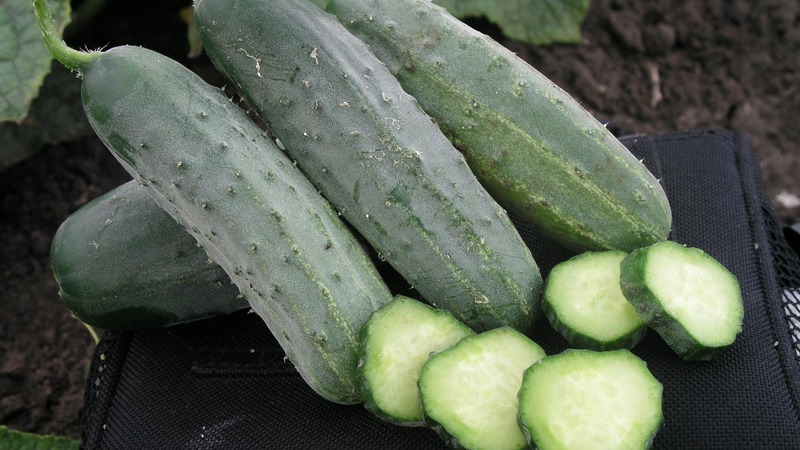
Properties, benefits, calorie content
The beneficial properties of cucumber are undeniable: it contains numerous trace elements and vitamins necessary for the human body. Due to its low calorie content, it is used in various diets for weight loss. The vegetable is indispensable in cosmetology, as it improves the natural turgor of the skin, helps to cleanse pores and easily whiten the skin.
Reference! Cucumber juice-based facial cosmetics are gentle and suitable for the sensitive area around the eyes.
In the composition of the cucumber, scientists have determined the presence of structured water. Structured water flushes the kidneys, removing toxins and waste products, and boosts immunity. The only drawback is that cucumbers should be used with caution for people suffering from chronic kidney disease.
It is interesting! Cucumber is 95% genetically similar to melon.
Plant characteristics
Determinate bush, undersized, height 75-80 cm, leaves are large, dark green, not prone to yellowing. Plants easily adapt to the vagaries of the weather, are resistant to a temporary drop in temperature, which makes it possible to grow crops throughout the territory of the Russian Federation.
Reference! Determinant - translated from Latin means limited. The stem of such plants grows to a certain length and stops growing.
Hector is distinguished by increased resistance to diseases of the pumpkin family, practically immune to powdery mildew and cucumber mosaic virus.
Ripening terms early, fruiting occurs 28-32 days after sowing the seeds.
Productivity is high, with 1 m², placing 5-7 seedlings, 4-6 kg of fruits are harvested.
Fruit characteristics
The length of a ripe fruit is 10-12 cm, the average weight is 100 g. The color is dark green, the rind is wrinkled, bumpy. The taste is expressive, with a sweetish undertone, without bitterness, the pulp is dense, juicy, with a characteristic cucumber aroma.
Ripe vegetables are universally applicable: they are used for cooking fresh meals and in winter storage.Since vegetables have a light spicy aroma, they not only perfectly complement the taste of dishes, but also combine with other vegetables.
Cucumbers can withstand transportation and long-term storage without losing their presentation.
How to grow a hybrid yourself
The hybrid can be grown in seedling and seedling methods. However, when planting in the ground, an early harvest will not work.
Direct planting of seeds in the ground
The soil for cucumber beds is prepared 2-3 weeks before sowing: it is dug up and fertilized with peat and humus.
Seeds are placed in grooves 2 cm deep with the nose up, since this method of sowing promotes faster germination seed... It is advisable not to use the beds on which plants of the pumpkin family used to grow. This is due to the fact that cucumbers belong to the same family and for full development they need substances that have already been taken from the soil by previous crops.
From hybrid crops, it will not work to prepare seeds for sowing on your own. But the purchased seeds, as a rule, do not need additional processing, since the manufacturer takes care of the quality himself.
Light cream-colored conventional seed... If the package contains grains of other colors (orange, blue, green), it means that they have been trained and are enriched with useful substances. If the grains are light, then you will have to disinfect. This is done simply: in a weak solution of potassium permanganate (dissolve 1 g in 100 ml of water) place the seeds for 20 minutes, then rinse with running water.
The constant air temperature should be at least +21 ° С, and the soil should be warmed up to + 16-17 ° С. At lower temperatures, seed can die in the soil. After sowing, the soil is moistened with warm, settled water from a sprayer.
Sowing seeds for seedlings
The preparation of seed for sowing is the same as for open ground. The planting container and the soil prepared at home are disinfected. You can plant in peat pots, eggshells. The main thing is that the planting container is separate for each seedling.
Reference! The root system of cucumbers is extremely vulnerable, so they are relieved of transplants into beds and picks.
The soil is prepared from garden soil, humus and dry sawdust in a ratio of 2: 2: 1. A little wood ash is added as fertilizer. Disinfect with a hot solution of potassium permanganate, fill the planting containers by two-thirds with disinfected soil.
 It is sown to a depth of 2 cm, sprinkled with soil on top, slightly moistened with warm, settled water from a spray bottle, covered with a film and left in a bright room at a temperature of + 22-24 ° C.
It is sown to a depth of 2 cm, sprinkled with soil on top, slightly moistened with warm, settled water from a spray bottle, covered with a film and left in a bright room at a temperature of + 22-24 ° C.
When seedlings appear, the film is removed, the containers are placed on the windowsill to obtain the required amount of light.
Water sparingly as the top layer of the soil dries out from a shallow watering can with warm, settled water. After watering, surface loosening is carried out, creating the necessary conditions for oxygen to pass to the roots.
After the appearance of 2 real leaves, the first feeding is applied: 10 g of nitrate, 20 g of superphosphate and 10 g of potassium sulfate are dissolved in 10 l of water. Top dressing is combined with watering or fertilizing is applied immediately after watering to the moistened soil.
Before planting in the ground, a second feeding is carried out by dissolving 50 g of superphosphate and 20 g of potassium sulfate in 10 liters of water.
Transplantation and further care of cucumbers Hector f1
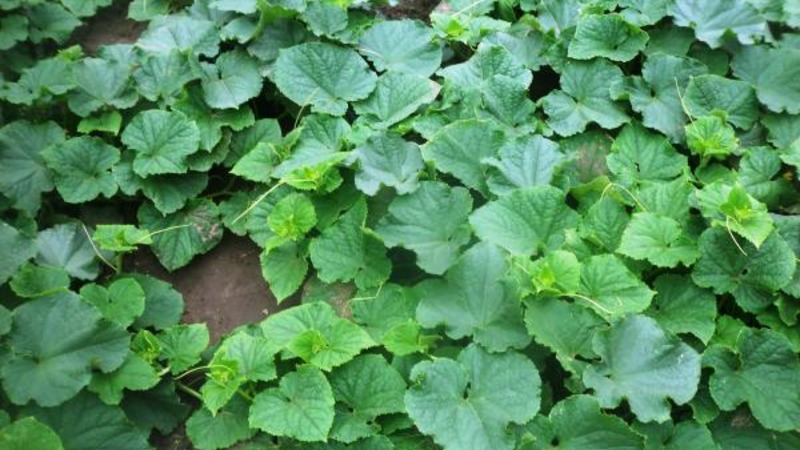
Landing scheme: 25 cm - distance between holes, 45 cm - distance between rows. No more than 7 seedlings are placed on 1 m². Before transplanting, the seedlings are moistened and moved to a new place along with the old clod of earth.
It is not worth deepening the seedlings, it is enough to sprinkle the roots of young plants. With deep seeding, there is a possibility of root rot.
Reference! According to the rules of crop rotation, the best predecessors of cucumber crops are lettuce, cabbage and green manure.
Caring for Hector's seedlings is no different from other crops and comes down to moderate watering, loosening and weeding the beds.
Water it twice a day, in the morning and in the evening, with water not lower than +20 ° C. After watering, the beds are loosened and weeds with roots are removed so that they do not interfere with the healthy growth of the seedlings.
To retain moisture in the beds, they are mulched with straw. In addition, mulch prevents the emergence of new weeds.
A full range of minerals and organics are used from dressings. Fertilize at least 3 times throughout the season, alternating the introduction of minerals with organic compounds. All top dressing is combined with watering.
Features in care and possible difficulties

Low-growing bushes do not need mandatory formation. Forming is carried out as desired. To do this, remove no more than 5 side shoots and pinch the main stem as soon as it reaches 70 cm.
The plant is so unpretentious that it develops well and bears fruit in a thickened planting.
Diseases and pests
The genes of the hybrid have a good resistance to such dangerous diseases as powdery mildew and cucumber mosaic. Also, the culture is protected from many other viral diseases.
When the plantings are thickened, the likelihood of developing fungal infections increases. By following the simplest preventive measures, you will save plants from diseases. Preventive measures include:
- moderate and timely watering with warm water;
- loosening and weeding of beds;
- mulching;
- ventilation of closed structures;
- control over the level of moisture and temperature conditions.
In case of a fungus infection, the leaves and stems are sprayed with the preparations "Fundazol" or "Topaz".
Reference! "Fundazol" and "Topaz" are therapeutic and prophylactic preparations related to fungicides.
The use of soapy water and nettle broth will help prevent pests. Soapy solution effectively protects seedlings from aphids, and decoctions of pungent-smelling herbs will not allow the whitefly to enter the beds.
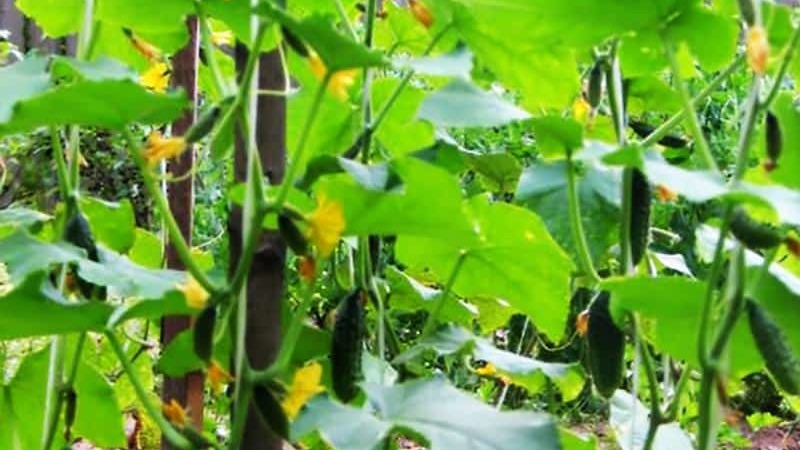
Harvesting and application of the crop
Harvesting is carried out 1 time in 2-3 days. When cucumbers overgrow, their skin coarsens, which negatively affects the taste. Therefore, timely collection of fruits is important during the fruiting period.
Ripe cucumbers are used universally due to their unique taste. They are suitable for preparing fresh dishes and go well in winter preparations: pickles, marinades, canned food.
Advantages and disadvantages of a hybrid
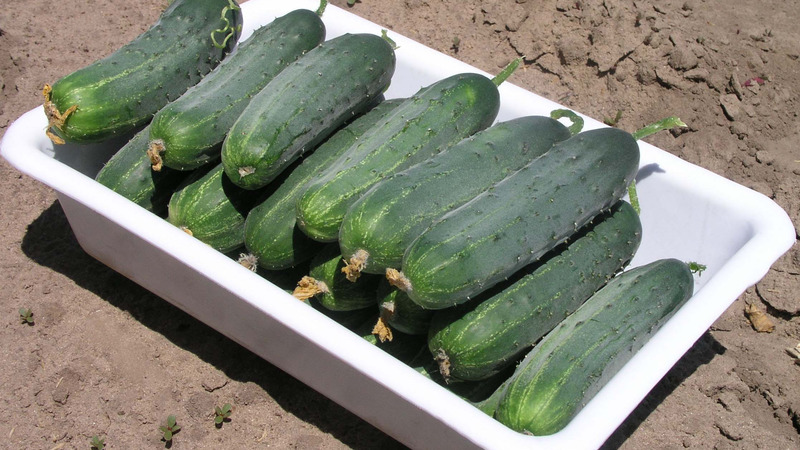
The positive properties of Hector cucumbers:
- cultivation in 2 ways - direct planting in the ground and seedling method;
- adaptation to any weather conditions;
- the possibility of breeding in any region;
- unpretentious care;
- increased resistance to disease;
- high productivity;
- great fruit taste;
- universal application;
- presentation and the possibility of quick implementation.
The disadvantages of the variety include:
- coarsening of the peel as a result of overgrowth;
- impossibility of self-collection of seeds.
Reviews
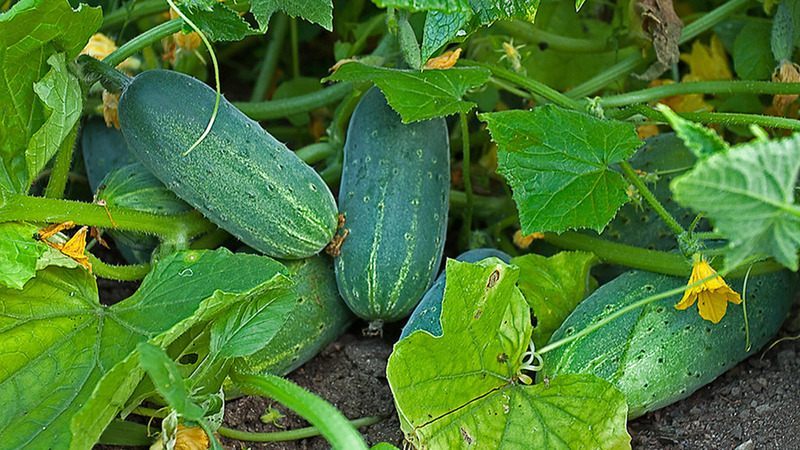
There are many positive reviews about the culture. Hector has fans who consider him an indispensable culture on their site.
Svetlana, Nizhny Novgorod: «I plant a little, 10 bushes each, but always with cucumbers. The seedlings do not get sick, they stand healthy all season, the leaves do not turn yellow. I make salads, side dishes from fruits, marinades and pickles... All dishes - just lick your fingers! "
Julia, Tver: “For me, it's not just a hybrid that produces excellent vegetables, but also a cosmetic product. The taste of fresh cucumbers is so unique that for many years I have not dared to plant any other variety in my garden. Moreover, in winter preparations, the fruits also retain their taste data. As for other qualities: Hector hybrid cucumbers are excellent for masks that help to rejuvenate the skin. "
Conclusion
Everyone who has a little time left for their summer cottage can confidently recommend the Hector f1 cucumbers.This is exactly the kind of culture about which they say "planted and forgot". The hybrid is characterized by strong immunity to diseases and a high rate of fruiting.
The universal use of the fruit makes it possible to prepare summer dishes and winter preparations. Cucumbers Hector will pamper a good harvest even for those gardeners who are growing vegetables for the first time.